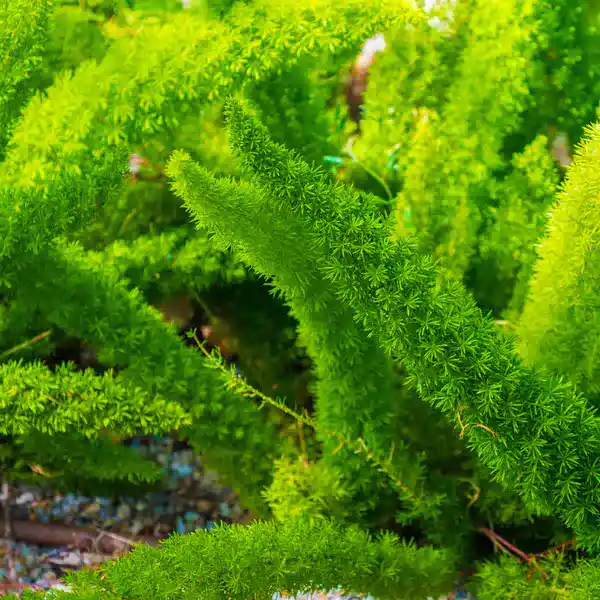The Myers Asparagus Fern or Asparagus densiflorus ‘Myers‘ also known as Foxtail Fern, is a beautiful and versatile plant that can enhance the aesthetics of any garden. Known for its delicate and lacy foliage, this fern species is highly prized for its ornamental value.
Not only does the Myers Asparagus Fern add beauty to any garden, but it is also relatively easy to care for. It is a hardy perennial that can grow well in a variety of soils and lighting conditions, making it an ideal choice for both beginner and experienced gardeners.
Whether you are looking to add texture and depth to your garden or simply want a low-maintenance plant that can thrive in your indoor space, the Myers Asparagus Fern is a great choice. In this article, we will explore all you need to know about growing, caring for, and propagating this beautiful fern species.
Growing Myers Asparagus Fern: Care Tips and Best Practices
If you’re looking to add the beautiful and versatile Myers Asparagus Fern to your garden, it’s important to understand how to care for it properly. Follow the below instructions to help your fern thrive.
Lighting
The Myers Asparagus Fern grows best in bright, indirect sunlight. Avoid placing your fern in direct sunlight, as this can cause its delicate fronds to scorch.
Watering
It’s important to keep the soil around your Myers Asparagus Fern consistently moist but not waterlogged. Water your fern regularly, but make sure the soil has drained before watering again. Overwatering can lead to root rot and other problems.
Soil Requirements
The ideal soil for the Myers Asparagus Fern is well-draining and rich in organic matter. A potting mix that includes peat moss, perlite, and vermiculite will provide the necessary nutrients and drainage.
Fertilization
Feed your Myers Asparagus Fern every two weeks during its growing season with a balanced, water-soluble fertilizer. During the winter months, reduce fertilization to once every four to six weeks to accommodate the plant’s slower growth.
Best Practices
Use a pot that is slightly larger than the root ball of your fern to allow for growth, and make sure the pot has drainage holes to prevent waterlogging. Prune your fern regularly to remove any dead or damaged fronds and promote new growth.
By following these tips and best practices, you can keep your Myers Asparagus Fern healthy and beautiful for years to come.

Myers Asparagus Fern Indoors: Bringing Nature into Your Home
The Myers Asparagus Fern is a versatile plant that is not just perfect for outdoor gardens but also for indoor spaces. This fern species is an excellent air purifier and requires minimal maintenance, making it an appealing option for those who want to bring nature into their homes without too much effort.
To ensure the success of the Myers Asparagus Fern indoors, it is important to position it in an area that receives indirect sunlight or in a spot where it can receive filtered light. It can also thrive in low-light conditions, making it an ideal plant for rooms with limited natural light.
When it comes to watering, the Myers Asparagus Fern should be watered thoroughly and then allowed to dry out before the next watering. Overwatering can lead to root rot, so it is vital to ensure the soil is well-draining.
In terms of soil, the Myers Asparagus Fern prefers well-aerated soil that is rich in organic matter. A mixture of potting soil and peat moss can provide the perfect growing medium.
The Myers Asparagus Fern is a plant that benefits from being root-bound. Therefore, it is essential to choose a pot that is slightly larger than the root ball. Repotting should only be done when the plant has outgrown its container.
Pruning the Myers Asparagus Fern indoors is also recommended to promote new growth and maintain its shape. However, it is important to keep the cuttings clean and sterilized to prevent the spread of diseases.
With proper care and maintenance, the Myers Asparagus Fern can be a beautiful and rewarding addition to any indoor space.
Propagating Myers Asparagus Fern: A Guide to Successful Propagation
Propagating Myers Asparagus Fern is a simple and cost-effective way to expand your collection or share with fellow gardeners. There are two primary methods for propagating this fern species: seed propagation and division. Both techniques are easy and effective.
Seed Propagation
Seed propagation is the most common method for propagating Myers Asparagus Fern. It involves sowing seeds in a well-draining potting mix and keeping the seeds moist until they germinate.
| Steps for Seed Propagation |
|---|
| Sow seeds in a well-draining potting mix |
| Keep the soil moist, but not too wet |
| Germination can take up to 6 weeks |
| Once the seedlings have grown large enough, transplant them to individual pots or a larger container |
It’s important to note that seed propagation can take a bit more time and patience than division propagation. However, it is a satisfying and rewarding process to see your ferns grow from tiny seeds to full-grown plants.
Division Propagation
The division is another effective method for propagating Myers Asparagus Fern. It involves separating the plant into smaller sections and replanting them in individual pots or a larger container. Division is a great way to refresh and rejuvenate an older plant or to create multiple plants from a single specimen.
| Steps for Division Propagation |
|---|
| Carefully remove the plant from its pot |
| Divide the plant into smaller sections, making sure each section has roots and leaves |
| Replant each section in individual pots or a larger container, depending on the size of the sections |
| Water the newly potted sections and keep them in a warm, bright location until they establish roots |
Propagation is a great way to enhance and expand your Myers Asparagus Fern collection. Whether you choose to propagate by seed or division, following these steps will help ensure success and a healthy plant.

Pruning Myers Asparagus Fern: Maintaining Shape and Health
Pruning your Myers Asparagus Fern is essential to ensure its healthy growth and maintain its shape. The best time to prune your fern is in late winter or early spring, just before the growing season begins.
To start, remove any yellow or brown fronds. These dead or dying fronds can attract pests or diseases and should be removed immediately. Use a sharp pair of scissors or pruning shears to make a clean cut, avoiding any damage to the surrounding healthy fronds.
You may also need to trim back overgrown fronds to control the fern’s size. Cut back the fronds to just above the crown of the plant, leaving at least a few inches of the frond intact. Avoid cutting too close to the crown or removing too many fronds at once, as this can damage the plant and hinder its growth.
Regular pruning will promote new growth and help your Myers Asparagus Fern stay healthy and vibrant. However, be careful not to over-prune, as this can stress the plant and make it more susceptible to pests and diseases.
Common Pests and Problems: How to Protect Your Myers Asparagus Fern
While the Myers Asparagus Fern is a hardy and easy-to-care-for plant, it can still be prone to certain pests and problems that can affect its health and growth. By recognizing and addressing these issues promptly, you can help keep your fern healthy and thriving. Here are some common pests and problems to watch out for:
| Problem | Symptoms | Treatment |
|---|---|---|
| Spider Mites | Yellow leaves, webbing on plant | Wash leaves with soapy water, apply neem oil or insecticidal soap |
| Scale Insects | Brown spots on leaves, sticky residue on plant | Wipe with alcohol-soaked cloth, apply insecticidal soap |
| Mushroom Root Rot | Wilting, yellowing, and dropping of leaves | Remove affected plant parts, improve drainage, avoid overwatering |
To prevent pest and disease problems, it’s important to provide your Myers Asparagus Fern with proper care, including regular watering and fertilizing, appropriate lighting, and good air circulation. Avoid overwatering, as this can lead to root rot and other issues. It’s also a good idea to inspect your fern regularly for signs of pests or disease, and to take action promptly if you notice any problems.
Tip: If you’re unsure about how to address a specific pest or problem affecting your Myers Asparagus Fern, consult with a professional gardener or plant expert for advice and guidance.
Conclusion: Enhance Your Garden with Myers Asparagus Fern
In conclusion, the Myers Asparagus Fern is a beautiful and versatile plant that can enhance the aesthetics of any garden. Its unique characteristics, such as its delicate foliage and air-purifying qualities, make it a popular choice among gardeners. With the right care and attention, this fern species can thrive both indoors and outdoors.
If you’re considering adding the Myers Asparagus Fern to your garden, be sure to follow the care tips and best practices outlined in this article. From lighting and watering to soil requirements and fertilization, taking the time to properly care for your fern will ensure its health and beauty for years to come.
Don’t forget to also consider propagation, pruning, and protection against common pests and problems. By taking these extra steps, you can keep your Myers Asparagus Fern looking its best and flourishing in your garden or indoor space.
So why not enhance your garden with the beauty and value of the Myers Asparagus Fern? Whether you’re a seasoned gardener or just starting out, this plant is an easy and rewarding addition to any outdoor or indoor space.













Comments are closed.